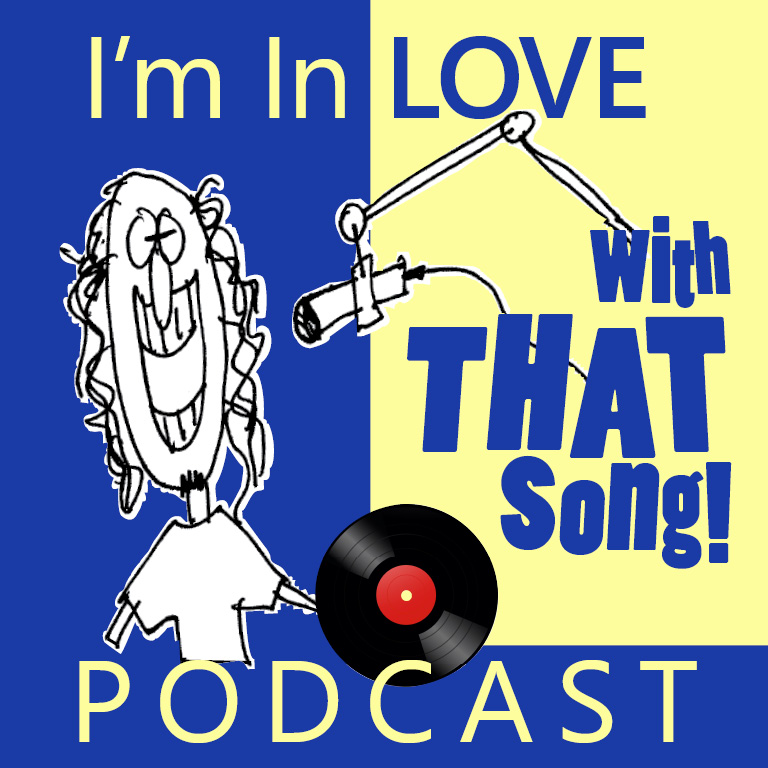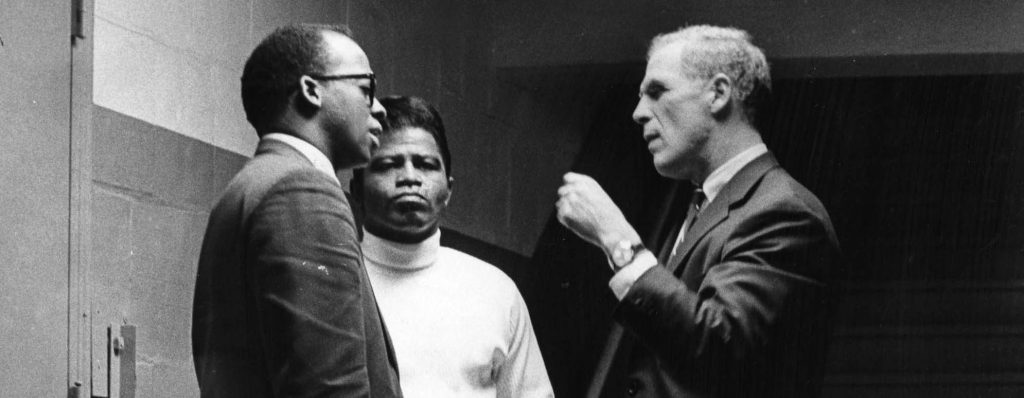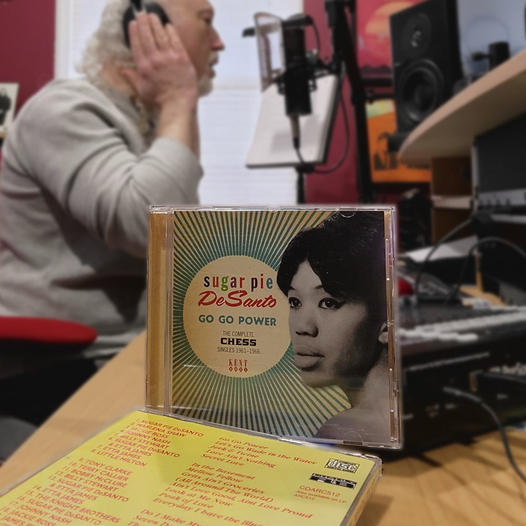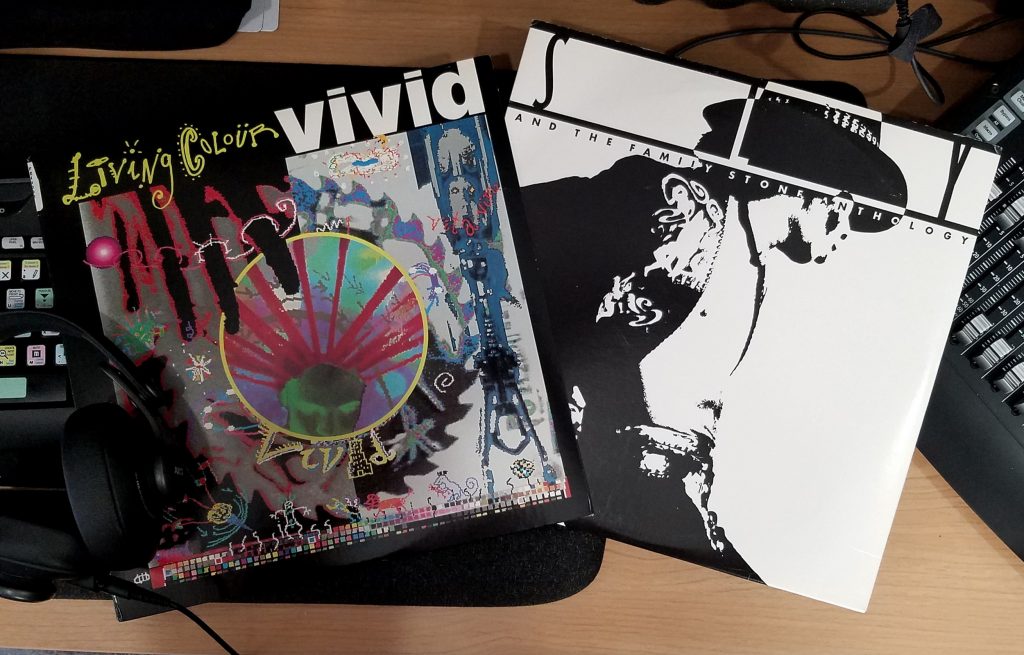It’s never a recipe for making great art when you’re under pressure to deliver an album to a rival record label due to contractual obligations… though Jimi Hendrix was never satisfied with the result, the Band Of Gypsys album became a very influential album and remains a favorite among Jimi fans and guitar players of all stripes. On this episode, we journey back to New Years 1970 to explore “Message of Love” from this legendary album.
“Message Of Love” (Jimi Hendrix) Copyright 1970 Experience Hendrix LLC
— Hey, I was just thinkin’… now would be as great time for you to check out the other Rock Podcasts on the Pantheon Podcasts network!
TRANSCRIPT:
Greetings to all, here on the third stone from the sun and beyond. This is the “I’m In Love With That Song” podcast beaming across the cosmos on the Pantheon Podcast Network. I’m your host, Brad Page, and each episode of the show, I pick a song and we explore it together, listening to all the nuances that make it one of my favorite songs. You don’t need any musical skill, knowledge or experience here– just a love for music and a little curiosity.
Well, here we are at the start of a brand new year, and I was trying to think of an appropriate subject for a January 1st episode. I thought, “we’ve talked about a lot of guitar players on this show…” I love guitar players. But I realized that, after over 140 shows, we’ve still never talked about one of the most important guitarists of all time. So let’s rectify that. It’s about time we talked about Jimi Hendrix.
Of course, Jimi Hendrix is a legend, with a legacy of some really important and influential records. It’d be tempting to pick a song like “Purple Haze” or “Voodoo Child”, “All Along The Watchtower”, or his version of “The Star Spangled Banner”. Those are all historically important tracks. But I wanted to do something different.
So, I chose a song from very late in his career when Jimi was at a turning point in his career– at a crossroads, to use a cliche. So, we’re going back to a New Year’s Eve over 50 years ago, when 1969 gave way to 1970, with Jimi Hendrix and the Band of Gypsys ringing in the new year at the Fillmore East, playing “Message Of Love”.
[Music]
Everybody knows that Jimi Hendrix is a legend, an icon. There are literally dozens of books written about him; there are documentaries. So I’m not going to go over a detailed history of Hendrix, but to understand how Jimi Hendrix ended up playing at the Fillmore East on New Year’s Eve, first we have to go back to his early years in New York City.
Jimi Hendrix was a working musician, paying his dues and playing as a sideman to people like the Isley Brothers and Little Richard. In 1965, he ended up as a guitarist in Curtis Knight’s band, playing cover songs on the New York and New Jersey circuit. Jimi eventually grew tired of that and formed his own band, Jimmy James and the Blue Flames.
It was during a stint playing in Greenwich Village, New York, when he was“discovered” by Chas Chandler, former bassist for The Animals, who was transitioning into being a manager. Chandler brought Jimi over to England, and they put together the Jimi Hendrix experience with bassist Noel Redding and drummer Mitch Mitchell. And the rest, as they say, is history.
Now here’s where things get messy. Back in ‘65, when he was playing with Curtis Knight, Jimmy had signed an exclusive recording contract with a guy named Ed Chaplin. Jimi had also signed a contract with producer Juggie Murray. But hey, look, Jimi was a struggling musician, just trying to find some success– any success. He was a guitar player, not a lawyer, and he was naive. He’d sign anything if he thought it could help him at the time.
But now, with the Jimi Hendrix Experience having hit records on the Warner Brothers label, Ed Chaplin came a calling in 1967 with his contract from two years earlier, and he sued.
Hendrix had made some recordings with Curtis Knight back in ‘65. Those records are not very good, but Chaplin licensed them to Capitol Records, who then released two albums worth of that stuff. In fact, at one point, you had the legit Warner Brothers records competing against the Capitol stuff at the same time.
Here’s a song from the Curtis Knight sessions; it’s an instrumental called “Knock Yourself Out”, which Jimi got a co-writing credit on.
{music]
Eventually, a settlement was arranged with an agreement that Ed Chaplin and Capitol Records would get the rights to one Jimi Hendrix album. Hendrix had just finished recording “Electric Ladyland”, which was a double album, so it was agreed that the next album would be given to Capitol.
But things in the Hendrix camp were tough. First, Chas Chandler had left the fold, and not long after, Noel Redding quit. Jimi brought in his old army buddy, Billy Cox, to play bass. Then Jimi rounded up a bunch more musicians, adding additional percussionists and a second guitar player. He called the band “Gypsy Sun and Rainbows”, and this was the band that played at Woodstock.
[Music]
But a month later, Jimmy broke up that band. It just wasn’t working for him.
Meanwhile, the pressure is on. He still owes one album to Capitol, and Jimi didn’t even have a band. So, Jimi, Billy Cox, and drummer-vocalist Buddy Miles put together a band. They made a deal with promoter Bill Graham to play four shows at the Fillmore East in New York: two shows on New Year’s Eve, and two shows on New Year’s Day, 1970. All four shows would be recorded, and they would release the best tracks as a single live album to fulfill the Capitol Records contract.
Before the show, Jimi, Buddy and Billy, calling themselves “Band of Gypsys”, worked up a set consisting mostly of new material, including “Machine Gun”, one of Jimi’s most incredible guitar performances.
Both Buddy and Billy were veterans of R&B bands, and they brought a funkier, soulful groove to the songs that the Jimi Hendrix Experience just never had. Buddy was also a great singer, too. His lead vocals are featured on two songs on the “Band of Gypsys” album. Buddy introduces this track on the record.
[Music]
The song starts off with a chromatically ascending riff before kicking off into the main riff of the song.
[Music]
Let’s just hear Jimi’s guitar on that riff.
[Music]
Behind that, Billy Cox is playing a pretty busy bass part over a pretty simple drumbeat, laid down by Buddy Miles. Let’s hear their parts.
[Music]
They only play through that riff twice before starting the first verse, which is a variation on the main riff, simplified a bit to leave room for the vocals.
[Music]
I really like the backing vocals there. One of the things about Jimi’s previous band, the Jimi Hendrix Experience, was that they didn’t have a strong vocalist in the band to back up Jimi. Buddy Miles was a powerhouse singer, and he adds a lot. And with Billy Cox chipping in, these backing vocals were kind of a whole new sound for Jimi.
[Music]
After a few lines of the verse, we get a new short riff with Jimi and Billy playing the same part together mostly. And that brings us back to the verse riff.
[Music]
And that brings us to another new riff. This one’s a little more rapid fire, with Jimi and Billy doubling the part, and Buddy scat singing the riff with them.
[Music]
Now here we have a somewhat quieter or gentler part. Jimi is playing some of those chords he was famous for; as much as he’s thought of as an incredible lead guitarist– and he was– he was also a killer rhythm player.
[Music]
Jimi’s rhythm guitar playing is as identifiable as his lead playing. Let’s hear this part again without the vocals, so that we can hear a little more of his guitar.
[Music]
The verse riff, the backing vocals come back in, but this time, Jimi’s just going to vamp a bit around the riff. At this point, Jimi is going to crank up the volume and play a solo, and I think now is as good a time as any to talk about Jimi’s guitar sound. Though he played other guitars, Jimi was primarily associated with the Fender Stratocaster. As a left-handed player, he would take a right-handed Strat, flip it upside-down and restring it, and that’s what he was playing this night with the Band Of Gypsys.
Now, playing the guitar upside-down like that meant that things like the volume & tone controls and the vibrato arm were in a different position than they would be if you were playing it normally. And Jimi was able to take advantage of that, particularly with the vibrato or whammy bar.
Jimi also pretty consistently used Marshall amplifiers, I think typically Super 100’s, but don’t quote me on that. But that was the standard beginning and end of his signal chain: a Fender Strat into a Marshall amp. But what went between his amp and guitar? That’s another story that changed frequently.
Jimi was always looking for new sounds, and he would explore any new effects gadget that came his way. Guitar effects pedals were still a relatively new thing in the late 60’s. Jimi was friends with a guy named Roger Mayer, an electrical engineer who had worked for the British Navy. He started building effects devices for guitars, like fuzz pedals, and one of the earliest units he built was the Octavia, which takes the input signal from the guitar and generates that sound one octave higher, then mixes it back in with the original guitar sound, and adds distortion or fuzz. Like most guitar pedals, it would sit on the floor between your guitar and amp, with a button you’d press with your foot to turn it on and off.
Jimi first used the Octavia on the solo for “Purple Haze” in 1967. Roger Mayer would continue to tweak and modify the Octavia for Hendrix. And Jimi was using one of those later versions for this Band Of Gypsys show.
You can hear the Octavia most notably on the song “Who Knows” from this show. Jimi was also using a fuzz pedal built by Roger Mayer. It was either a Fuzz Face or an Axis Fuzz, depending on what you read. He had two other effects pedals on stage this night: a Vox wah-wah pedal, which you can hear on the song “Changes”:
[Music]
And he was using a Univibe, a new and pretty innovative pedal for its time. It’s a little tough to explain what a Univibe actually sounds like– it’s a cross between phasing, a chorus sound, and vibrato, but you can hear it in action on the song “Machine Gun”.
[Music]
Now, there is one other thing to take into account regarding Jimi’s guitar sound, and that’s the order in which the effects are plugged into each other. Believe it or not, it makes a big difference in the sound. For example, a wah-wah pedal plugged into a fuzz pedal sounds significantly different than the other way around, a fuzz pedal plugged into a wah. This can lead to endless rounds of debate and conjecture, but luckily, we have some photographs from this show that pretty clearly show the sequence of his pedals that night:
His guitar is plugged into a Vox wah-wah pedal, which is plugged into the Octavia, which is plugged into the Fuzz Face, that’s plugged into the Univibe, and then that is finally plugged into his Marshall amplifier. Wah pedal, Octavia, Fuzz pedal, Univibe.
Okay, so back to “Message Of Love”. At this point, the fuzz is really going to kick in, and Jimi’s going to go for his first solo.
[Music]
And now, Jimi’s going to step on that wah-wah pedal.
[Music]
Now Jimi’s gonna hit a harmonic and quickly bend it down with the whammy bar, then turn off the wah pedal for the rest of the solo.
[Music]
You can hear them slow the tempo down there.
[Music]
The band is going to break, and then Jimi is going to do a little scat singing, this time singing along to his guitar part.
[Music]
They’re gonna build it back up here. Jimi and Buddy are gonna add some vocals.
[Music]
It sounds a little rough coming back into the riff there. I can’t imagine they had more than a handful of rehearsals before these shows, so there’s bound to be some rough spots. But that’s what makes this a truly great live album. There’s a real “edge of your seat” energy to this record. They didn’t go back and fix up every mistake– this is how it really went down that night, New Year’s 1975.
Jimmy’s gonna cut loose with the second solo. Let’s focus in on Jimmy’s guitar.
[Music]
They bring back that chromatic climb from the beginning of the song to wrap it all up. Jimi’s just messing around with the whammy bar and some feedback.
[Music]
The Band of Gypsys – “Message Of Love”
The song has also been credited as “Message To Love”, but on all the versions of “Band of Gypsys” that I have, it’s referred to as “Message Of Love”. So that’s what I’m sticking with.
The “Band of Gypsys” album was commercially very successful. Critics didn’t necessarily love it, and Hendrix himself was never satisfied with it; he felt it was rushed and it didn’t sound great, and if it wasn’t for the contractual obligations, he wouldn’t have released it. Not that it mattered. By the time the album was released, the band had already broken up.
But the album has gone on to be very influential, paving the way for future funk rock acts. And it was an important touchstone, particularly for black artists making their mark in the rock world, like Living Color and Lenny Kravitz. And it remains one of my favorite Jimi Hendrix records, and just favorite guitar records in general.
Thanks for joining me for this musical journey on the “I’m In Love With That Song” podcast. As always, I’ll be back in about two weeks with another new episode. Until then, get your fix of the “I’m In Love With That Song” podcast by listening to any of our previous shows on our website, lovethatsongpodcast.com, or find us on your favorite podcast app.
You can keep in touch with us on Facebook, just look for the “I’m In Love With That Song” podcast to find our page. And please support the show by sharing it with your friends and just telling somebody about it.
On behalf of the Pantheon Network of podcasts, I gently remind you to support the artists that you love by buying their music, and I’ll see you back here next time. Thanks for listening to this episode on Jimi Hendrix and the Band of Gypsys. Happy New Year, everyone.
ADDITIONAL INFORMATION:
Jimi Hendrix
https://en.wikipedia.org/wiki/Jimi_Hendrix
Band of Gypsys
https://en.wikipedia.org/wiki/Band_of_Gypsys
Message of Love
https://en.wikipedia.org/wiki/Message_of_Love
Fillmore East
https://en.wikipedia.org/wiki/Fillmore_East
Fender Stratocaster
https://en.wikipedia.org/wiki/Fender_Stratocaster
Marshall amplifier
https://en.wikipedia.org/wiki/Marshall_Amplification
Octavia pedal
https://en.wikipedia.org/wiki/Octavia_(effect)
Fuzz Face
https://en.wikipedia.org/wiki/Fuzz_Face
Univibe
https://en.wikipedia.org/wiki/Univibe
Wah-wah pedal
https://en.wikipedia.org/wiki/Wah-wah_pedal
Billy Cox
https://en.wikipedia.org/wiki/Billy_Cox
Buddy Miles
https://en.wikipedia.org/wiki/Buddy_Miles

 Click here to play the podcast
Click here to play the podcast
 Click here to play the episode
Click here to play the episode
